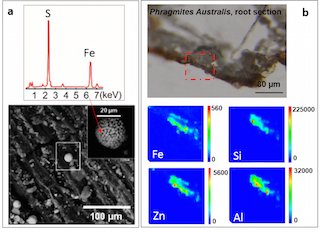Multi-method approach sheds light on the potential of plants to attenuate metals’ load in natural water resources
|Extensive industrial mining often causes environmental problems. Many former mining sites around the world are heavily polluted with poisonous heavy metals that make the areas dangerous to live in, often for decades. For this reason, the last 25 years saw a rise in the development of remediation technologies to make those polluted zones habitable again. But the processes that the heavy metals undergo over a long time in a natural environment are complex and not completely understood, yet. Especially the influence of the exchange between the geosphere, the soil and water, and the biosphere, the plants and organisms, is mainly unknown. On the other hand, an understanding of these biosphere-geosphere interactions could lead to a significant step forward in the development of sustainable remediation techniques.
The research team around Giovanni De Giudici from the University of Cagliari, in Sardinia – Italy, is taking up the challenge of understanding how plants influence the behaviour of heavy metals in polluted rivers.

Together with researchers from the U.S. Geological Survey, they performed a large multi-technique study on heavy metals in the Sardinian river of Rio San Giorgio [1]. The area of that river has been exposed to heavy Lead and Zinc mining since centuries, up to 20 years ago. For this reason, the area has been heavily polluted. De Giudici’s study focuses on the so-called hyporheic zone, which is the shallow shore of the river. Here the water flows naturally very slow and the vegetation is very dense. This allows a maximum interaction between the water and the surrounding environment. The researchers were taking plant and soil samples from this zone at different point of the river to see how the pollutants are distributed.
For the detection of pollutants in the samples, they used X-ray microscopy at the TWINMIC beamline and X-ray absorption spectroscopy at the XAFS beamline, both from the CERIC Italian Partner Facility at Elettra in Trieste. The combination of the two techniques enables the simultaneous determination of the concentration and the chemical state of heavy metals in different parts of the soil and the plant. This allows conclusions about how much pollutant is filtered from the water and in which composition it is stored in the plants and soil.
Watch the video interview with Prof. Giovanni De Giudici:
As a result of this study, the researchers could create a map of pollutants in the hyphoreic zone of the river. A big part of the heavy metals found in the water is oxidized and stored in the plants’ roots, but some of it is also found in the stem and the leaves. An additional result was particularly surprising. The scientists found a high concentration of the mineral pyrite in the soil around the plants’ roots. This iron-containing mineral suggests that the plant is influencing the chemical environment and supports chemical processes that lead to the storage of poisonous heavy metals into non poisonous minerals. It has been estimated that this effect can lead to an apparent decrease in Zn load up to 60%. This effect was by now unknown and, when fully investigated, might open new ways of using plants as more effective filters and cleaners in polluted areas.



